Section Quercus Rank Species | Genus Quercus Scientific name Quercus alba Higher classification Oak | |
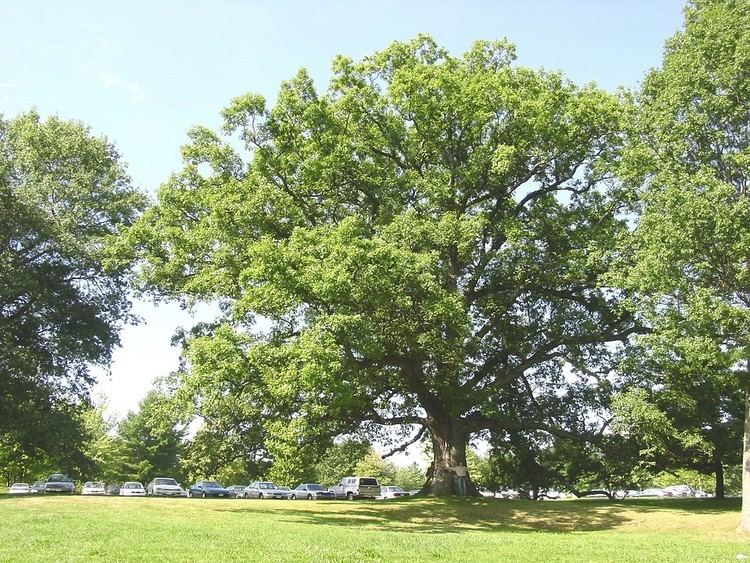 | ||
Similar Oak, Northern Red Oak, Hickory, Sugar maple, Quercus velutina | ||
Quercus alba, the white oak, is one of the preeminent hardwoods of eastern and central North America. It is a long-lived oak, native to eastern and central North America and found from Minnesota, Ontario, Quebec, and Nova Scotia south as far as northern Florida and eastern Texas. Specimens have been documented to be over 450 years old.
Contents
- White oak quercus alba growing white oak
- Description
- Distribution
- Cultivation
- Woodcraft
- Wildlife food
- Oak barrels
- In culture
- Chemistry
- References
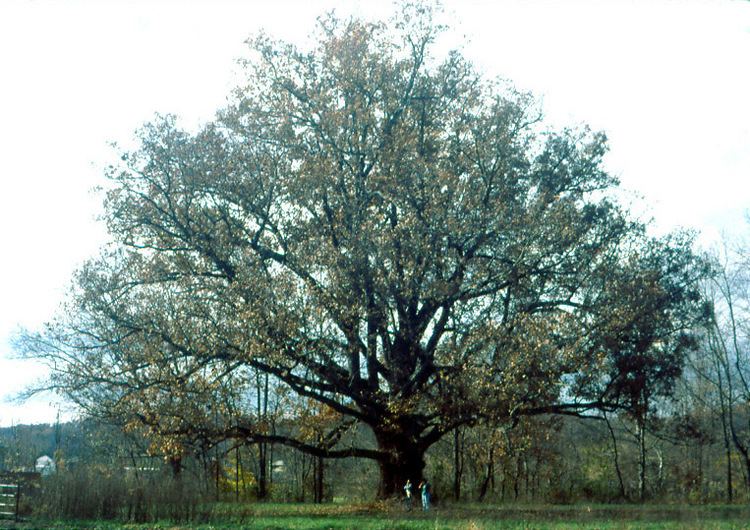
Although called a white oak, it is very unusual to find an individual specimen with white bark; the usual color is a light gray. In the forest it can reach a magnificent height and in the open it develops into a massive broad-topped tree with large branches striking out at wide angles.
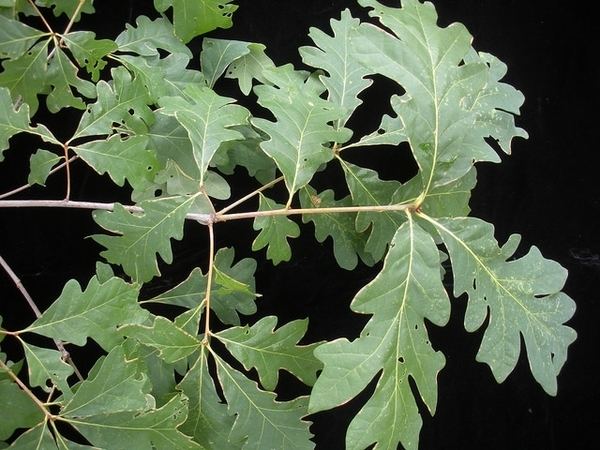
White oak quercus alba growing white oak
Description
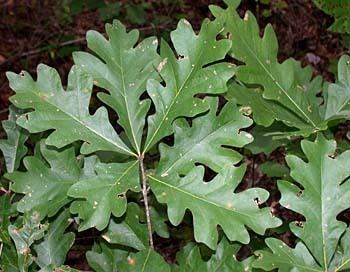
Q. alba typically reaches heights of 80 to 100 feet (24–30 m) at maturity, and its canopy can become quite massive as its lower branches are apt to extend far out laterally, parallel to the ground. Trees growing in a forest will become much taller than ones in an open area which develop to be short and massive. The tallest known white oak is 144 feet (44 m) tall. It is not unusual for a white oak tree to be as wide as it is tall, but specimens growing at high altitudes may only become small shrubs.
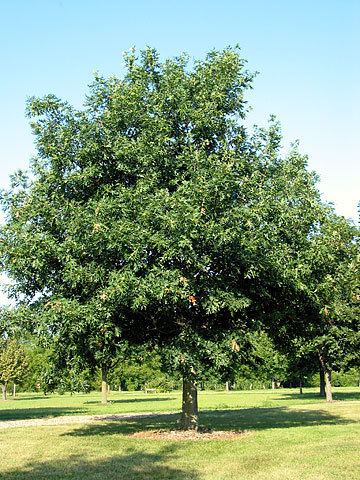
White oak may live 200 to 300 years, with some even older specimens known. The Wye Oak in Wye Mills, Maryland was estimated to be over 450 years old when it finally fell in a thunderstorm in 2002.

Another noted white oak is the Great White Oak in Basking Ridge, New Jersey, estimated to be over 600 years old. The tree measures 25 feet (7.6 m) in circumference at the base and 16 feet (4.9 m) in circumference four feet (1.2 m) above the ground. The tree is 75 feet (23 m) tall, and its branches spread over 125 feet (38 m) from tip to tip. The oak, claimed to be the oldest in the United States, began showing signs of poor health in the mid-2010s. The tree was declared dead in 2016 and was planned to be taken down in 2017.

Sexual maturity begins at around 20 years, but the tree does not produce large crops of acorns until its 50th year and the amount varies from year to year. Acorns deteriorate quickly after ripening, the germination rate being only 10% for six-month-old seeds. As the acorns are prime food for animals and insects, all may be lost in years of small crops.
The bark is a light ash-gray and peels somewhat from the top, bottom and/or sides.
In spring the young leaves are of a delicate, silvery pink and covered with a soft, blanket-like down. The petioles are short, and the leaves which cluster close to the ends of the shoots are pale green and downy with the result that the entire tree has a misty, frosty look. This condition continues for several days, passing through the opalescent changes of soft pink, silvery white and finally yellow green.
The leaves grow to be 5 to 8.5 inches (13–22 cm) long and 2.75 to 4.5 inches (7.0–11.4 cm) wide and have a deep glossy green upper surface. They usually turn red or brown in autumn, but depending on climate, site, and individual tree genetics, some trees are nearly always red, or even purple in autumn. Some brown, dead leaves may remain on the tree throughout winter until very early spring. The lobes can be shallow, extending less than halfway to the midrib, or deep and somewhat branching.
The acorns are usually sessile, and grow to 0.5 to 1 inch (13–25 mm) in length, falling in early October.
Quercus alba is sometimes confused with the swamp white oak, a closely related species, and the bur oak. The white oak hybridizes freely with the bur oak, the post oak, and the chestnut oak.
Distribution
Q. alba is fairly tolerant of a variety of habitats, and may be found on ridges, in valleys, and in between, in dry and moist habitats, and in moderately acid and alkaline soils. It is mainly a lowland tree, but reaches altitudes of 5,249 ft in the Appalachian Mountains. It is often a component of the forest canopy in an oak-heath forest.
Cultivation
Quercus alba is cultivated as an ornamental tree somewhat infrequently due to its slow growth and ultimately huge size. It is not tolerant of urban pollution and road salt and due to its large taproot, is unsuited for a street tree or parking strips/islands.
Woodcraft
White oak has tyloses that give the wood a closed cellular structure, making it water- and rot-resistant. Because of this characteristic, white oak is used by coopers to make wine and whiskey barrels as the wood resists leaking. It has also been used in construction, shipbuilding, agricultural implements, and in the interior finishing of houses.
It was a signature wood used in mission style oak furniture by Gustav Stickley in the Craftsman style of the Arts and Crafts movement.
White oak is used extensively in Japanese martial arts for some weapons, such as the bokken and jo. It is valued for its density, strength, resiliency and relatively low chance of splintering if broken by impact, relative to the substantially cheaper red oak.
USS Constitution is made of white oak and southern live oak, conferring additional resistance to cannon fire. Reconstructive wood replacement of white oak parts comes from a special grove of Quercus alba known as the "Constitution Grove" at Naval Surface Warfare Center Crane Division.
Wildlife food
The acorns are much less bitter than the acorns of red oaks. They are small relative to most oaks, but are a valuable wildlife food, notably for turkeys, wood ducks, pheasants, grackles, jays, nuthatches, thrushes, woodpeckers, rabbits, squirrels, and deer. The white oak is the only known food plant of the Bucculatrix luteella and Bucculatrix ochrisuffusa caterpillars.
The young shoots of many eastern oak species are readily eaten by deer. Dried oak leaves are also occasionally eaten by white-tailed deer in the fall or winter. Rabbits often browse twigs and can girdle stems.
Oak barrels
Barrels made of American white oak are commonly used for oak aging of wine, in which the wood is noted for imparting strong flavors. Also, by federal regulation, bourbon whiskey must be aged in charred new oak (generally understood to mean specifically American white oak) barrels.
In culture
White oak has served as the official state tree of Illinois after selection by a vote of school children. There are two "official" white oaks serving as state trees, one located on the grounds of the governor's mansion, and the other in a schoolyard in the town of Rochelle. The white oak is also the state tree of Connecticut and Maryland. The Wye Oak, probably the oldest living white oak until it fell because of a thunderstorm on June 6, 2002, was the honorary state tree of Maryland.
Being the subject of a legend as old as the colony itself, the Charter Oak of Hartford, Connecticut is one of the most famous white oaks in America. An image of the tree now adorns the reverse side of the Connecticut state quarter.
The white oak from the movie The Shawshank Redemption, known as the "Shawshank Tree" and the "Tree of Hope", was estimated to be more than 200 years old when it fell. The tree is seen during the last ten minutes of the movie. As the movie gained fame, the tree became popular as well, and used to attract tens of thousands of movie fans and tourists every year. A portion of the tree came down on July 29, 2011, when the tree was split by lightning during a storm. The remaining half of the tree fell during heavy winds almost exactly five years later, on July 22, 2016.
Chemistry
Grandinin/roburin E, castalagin/vescalagin, gallic acid, monogalloyl glucose (glucogallin) and valoneic acid dilactone, monogalloyl glucose, digalloyl glucose, trigalloyl glucose, ellagic acid rhamnose, quercitrin and ellagic acid are phenolic compounds found in Q. alba.
